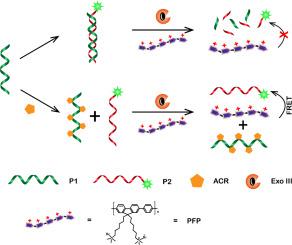International Journal of Biological Macromolecules ( IF 7.7 ) Pub Date : 2022-08-04 , DOI: 10.1016/j.ijbiomac.2022.07.251 Yufei Liu 1 , Suyu Meng 1 , Jingjing Qin 2 , Ruiying Zhang 1 , Ningning He 3 , Yaoyao Jiang 1 , Hong Chen 1 , Na Li 1 , Ying Zhao 4

|
As a toxic substance on human health produced in food thermal treatment, simple analytical approaches are highly desired for the detection of acrylamide (ACR) in foods. With the aid of exonuclease III (Exo III), a simple fluorescence sensor was proposed based on carboxyfluorescein-labeled double-stranded DNA (FAM-dsDNA) and a cationic conjugated polymer (PFP). Fluorescence resonance energy transfer (FRET) efficiency between FAM and PFP was changed with and without ACR. When ACR was present, ACR and single-stranded DNA (P1, ssDNA) formed an adduct, allowing free FAM-labeled complementarity strand DNA (P2, FAM-csDNA) to appear in the solution and avoiding the digestion of P2 by Exo III. After the addition of PFP, the interaction of PFP and FAM induced strong FRET. Under optimized conditions, ACR was detected with a limit of detection (LOD) of 0.16 μM. According to this biosensor, a LOD of 1.3 μM in water extract samples was observed with a good recovery rate (95–110 %).
中文翻译:

基于双链 DNA 和阳离子共轭聚合物与核酸外切酶 III 偶联的荧光生物传感器用于丙烯酰胺检测
作为食品热处理过程中产生的对人体健康有害的物质,非常需要简单的分析方法来检测食品中的丙烯酰胺(ACR)。在核酸外切酶III(Exo III)的帮助下,提出了一种基于羧基荧光素标记的双链DNA(FAM-dsDNA)和阳离子共轭聚合物(PFP)的简单荧光传感器。FAM 和 PFP 之间的荧光共振能量转移 (FRET) 效率在有和没有 ACR 的情况下发生了变化。当 ACR 存在时,ACR 和单链 DNA(P1,ssDNA)形成加合物,使游离的 FAM 标记的互补链 DNA(P2,FAM-csDNA)出现在溶液中,避免了 Exo III 对 P2 的消化。添加 PFP 后,PFP 和 FAM 的相互作用诱导了强烈的 FRET。在优化条件下,ACR 的检测限 (LOD) 为 0。16微米。根据该生物传感器,在水提取物样品中观察到的 LOD 为 1.3 μM,具有良好的回收率 (95–110%)。











































 京公网安备 11010802027423号
京公网安备 11010802027423号